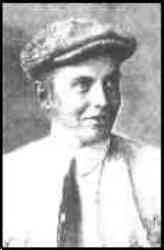

|
| Photo Courtesy of Carroll Gray. |
| The United States was slower than France in issuing pilot's licenses and establishing the rules under which they could be granted. Regulations published in 1910 stated: "All candidates shall satisfy the officials of the Aero Club of America of their ability to fly at least five hundred yards, and of their capability of making a gliding descent with the engine stopped, before their applications will be entertained. Up to the time of Belmont Park, twenty-five such licenses had been issued . The first nine of these were as follows: |
| 1. Glenn Curtiss | Curtiss biplane and motor | |
| 2. Frank P. Lahm | Wright biplane and motor | |
| 3. Louis Paulhan | H. Farman biplane, | |
| Gnôme motor | ||
| 4. Orville Wright | Wright biplane and motor | |
| 5. Wilbur Wright | Wright biplane and motor | |
| 6. Clifford B. Harmon | H. Farman biplane | |
| Gnôme motor | ||
| 7. Thomas S. Baldwin | Curtiss biplane and motor | |
| 8. J. Armstrong Drexel | Blériot monoplane, | |
| Gnôme motor | ||
| 9. Todd Shriver | Curtiss biplane and motor |
| 1. | Max T. Lillie |
| 2. | Glenn L Martin |
| 3. | Lieutenant T. DeWitt Milling, USA |
| 4. | Lieutenant Henry H. Arnold, USA |
| 5.. | Captain Charles deF. Chandler, USA |
| 6. | Captain Paul W. Beck, USA |
| 7. | Lieutenant Benjamin D. Foulois, USA |
| 8. | DeLloyd Thompson |
| 9. | Lieutenant Harold Geiger, USA |
|
1913 July 8: Not until 1913 was sufficient interest aroused in the United States to warrant a contest for water craft. Under the auspices of Aero & Hydro , a Great Lakes "Reliability Cruise" was organized for the week of July 8--the course to follow the shoreline from Chicago to Detroit via the Straits of Mackinac. It was heralded as the biggest competitive aerial event of the year. Most of the pilots who had taken up the practice of flying over water were on the entry list - a total of fifteen names. John B. R. Verplanck, an affluent sportsman from the Hudson River Valley, and his seasoned pilot, Beckwith Havens, entered a Curtiss flying boat with a 90-hp Curtiss motor, as did Charles C. Witmer, Jack Vilas, G.M. Hecksher, and Navy Lieutenant John H. Towers,Antony Jannus, Hugh Robinson, and Tom Benoist entered Benoist flying boats, each with a Hall-Scott motor of 100 hp. Others on the original list were Max Lillie piloting a Walco monoplane flying boat with a 70-hp Sturtevant motor. 1913 Of the first thirty-three fatal accidents, the twin-propellered Wright biplane accounted for more than a quarter. As a consequence of this unlucky record, the American machine came to be looked upon by many flyers as a "killer". In addition to Ralph Johnstone and Arch Hoxsey (the "Heavenly Twins"), who died in 1910, pilots killed in Wrights over the next few years included such skilled Americans as Calbraith Rodgers, Howard Gill, A.L. Welch, Philip O. Parmalee, and Max Lillie- holder of Expert Aviator's Certificate No. 1. In nearly every instance the aviator, sitting on the leading edge of the plane with no protection forward, was pitched out when the plane crashed. AMERICAN AVIATION HISTORICAL SOCIETY JOURNAL, VOLUME 4, NUMBER 3, FALL, 1959. The article is titled "The Flying Pioneers of Aviation" by Harold E. Morehouse 

|